
HMS Hyperion was an H-class destroyer built for the Royal Navy during the mid-1930s. During the Spanish Civil War of 1936–1939, the ship enforced the arms blockade imposed by Britain and France on both sides as part of the Mediterranean Fleet. During the first few months of World War II, Hyperion searched for German commerce raiders in the Atlantic Ocean and blockaded German merchant ships in neutral harbours until she returned to the British Isles in early 1940. The ship participated in the Norwegian Campaign before she was transferred back to the Mediterranean Fleet shortly afterwards. Hyperion participated in the Battle of Calabria and the Battle of Cape Spada in July 1940 while escorting the larger ships of the fleet. The ship covered several convoys to Malta before she struck a mine and was deliberately scuttled in December 1940.

HMS Hostile (H55) was an H-class destroyer built for the Royal Navy in the 1930s. She was the first and so far only Royal Navy ship to bear the name Hostile. During the Spanish Civil War of 1936–1939 the ship spent considerable time in Spanish waters, enforcing the arms blockade imposed by Britain and France on both sides of the conflict. She was transferred to Freetown, Sierra Leone, in October 1939 to hunt for German commerce raiders in the South Atlantic with Force K. Hostile participated in the First Battle of Narvik in April 1940 and the Battle of Calabria in July 1940. The ship was damaged by a mine off Cape Bon in the Strait of Sicily while on passage from Malta to Gibraltar on 23 August 1940. She was then scuttled by HMS Hero.

HMS Glowworm was a G-class destroyer built for the Royal Navy in the mid-1930s. During the Spanish Civil War the ship spent part of 1936 and 1937 in Spanish waters, enforcing the arms blockade imposed by Britain and France on both sides of the conflict. Glowworm was transferred from the Mediterranean Fleet shortly after the beginning of World War II to the British Isles, to escort shipping in local waters. In March 1940, she was transferred to the Home Fleet, just in time to participate in the opening stages of the Norwegian Campaign. On 8 April 1940 Glowworm encountered German destroyers transporting troops to invade Norway in Operation Weserübung. The German destroyers attempted to disengage while calling for help from the heavy cruiser Admiral Hipper. Glowworm was heavily damaged by Admiral Hipper, but still attempted to torpedo the German ship. In chaos of the battle, the heavily damaged Glowworm rammed Admiral Hipper, which broke off the destroyer's bow and she sank shortly afterwards.
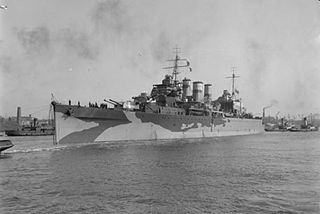
HMS Suffolk, pennant number 55, was a County-class heavy cruiser of the Royal Navy, and part of the Kent subclass. She was built by Portsmouth Dockyard, Portsmouth, UK, with the keel being laid down on 30 September 1924. She was launched on 16 February 1926, and commissioned on 31 May 1928. During the Second World War, Suffolk took part in the Norwegian Campaign in 1940 and then the Battle of the Denmark Strait in 1941, before serving in the Arctic throughout the following year. After a refit that concluded in April 1943, the cruiser served in the Far East until the end of the war. In the immediate post-war period, Suffolk undertook transport duties between the Far East, Australia and the United Kingdom before being placed in reserve in mid-1946. The vessel was sold off and then scrapped in 1948.

HMS Galatea was an Arethusa-class light cruiser of the Royal Navy. She was built by Scotts Shipbuilding & Engineering Co., with the keel being laid down on 2 June 1933. She was launched on 9 August 1934, and commissioned 14 August 1935.

HNoMS Norge was a coastal defence ship of the Eidsvold-class in the Royal Norwegian Navy. Built by Armstrong Whitworth at Newcastle on Tyne, she was torpedoed and sunk by German destroyers in Narvik harbour on 9 April 1940.
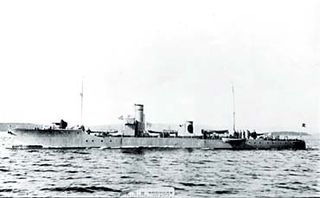
HNoMS Trygg was a torpedo boat of the Royal Norwegian Navy. Her hull was built in Moss and she was finished in Horten, with build number 109. Trygg had two sister ships: HNoMS Snøgg and HNoMS Stegg. Together the three vessels formed the Trygg class of torpedo boats.

HNoMS Tordenskjold, known locally as Panserskipet Tordenskjold, was a Norwegian coastal defence ship. She, her sister ship, Harald Haarfagre, and the slightly newer Eidsvold class were built as a part of the general rearmament in the time leading up to the events in 1905. Tordenskjold remained an important vessel in the Royal Norwegian Navy until she was considered unfit for war in the mid-1930s.
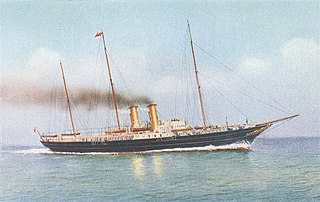
HMY Alexandra was a steamship built as a British royal yacht, completed in 1908. Normally transporting Britain's royal family to European ports, Alexandra served as a hospital ship during the First World War. After 17 years of British service, she was sold to Norwegian commercial interests in 1925. Renamed Prins Olav, she was first used as a luxury cruise ship on trips to the North Cape, she was converted to take more passengers and cargo. In 1937 she began sailing as a Hurtigruten passenger/cargo ship along the coast of Norway. After being requisitioned by the Norwegian government following the 9 April 1940 German invasion of Norway, she transported troops for the Norwegian war effort. Prins Olav was sunk by German bombers on 9 June 1940, while attempting to escape to the United Kingdom as the Norwegian Campaign was coming to an end.
The mine layer HNoMS Laugen was built for the Royal Norwegian Navy during World War I, as the lead ship of a two ship class. Her sister ship was Glommen.

HNoMS Gyller was a Sleipner-class destroyer commissioned into the Royal Norwegian Navy in 1938. Along with the other Sleipner-class vessels in commission at that time, she took part in protecting Norwegian neutrality during the Second World War. After initially serving in the far north during the Finno-Soviet Winter War, she was redeployed to Southern Norway, escorting ships through Norwegian territorial waters. When the Germans invaded Norway on 9 April 1940, she was docked at Kristiansand. After taking part in the defence of the port city, she was captured intact by the invading Germans. Renamed Löwe, she sailed with Nazi Germany's Kriegsmarine for the duration of the war.

HNoMS Odin was a Sleipner-class destroyer that entered service with the Royal Norwegian Navy in 1939. She and the other Sleipner-class vessels were built as part of a Norwegian rearmament scheme in the last years leading up to the Second World War. In 1940, she had taken part in protecting Norwegian neutrality, before being caught in the German invasion of Norway on 9 April 1940. After fighting the invasion forces at Kristiansand, she was captured and pressed into Kriegsmarine service for the duration of the war. After the end of the war, she was returned to Norway. In 1948, she and her surviving sister ships were converted to frigates and remained in service until sold for scrapping in 1959.

HNoMS Otra was an Otra-class minesweeper built in 1939 for the Royal Norwegian Navy. Captured by the Germans during the 1940 invasion of Norway and renamed Togo, she was returned to the Norwegians in 1946. Otra remained in service until being sold for scrapping in 1963.
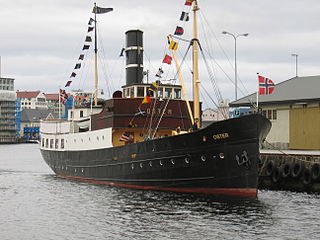
SS Oster is a Norwegian steamship built in 1908 by Christianssands Mekaniske Værksted for the Indre Nordhordlandske Dampskibsselskab to provide a combined passenger and cargo service between Bergen and Osterfjorden in Norway. During World War II she served as a guard ship with both the Royal Norwegian Navy and later with the German Kriegsmarine. Following the war she returned to civilian service and is still in service providing pleasure cruises from Bergen. In 1963 the Bergen deaf priest Ragnvald Hammer wrote the poem " Dar kjem dampen" in honor of the ship. Norwegian folksinger Ivar Medaas later added a tune to this poem.
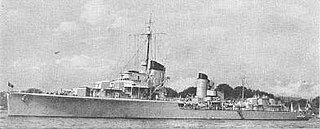
The German destroyer Z2 Georg Thiele was one of four Type 1934-class destroyers built for the German Navy (Kriegsmarine) during the mid-1930s. She was named after Georg Thiele, a Korvettenkapitän who commanded the Seventh Half Flotilla of torpedo boats. Completed in 1937, two years before the start of World War II, the ship spent most of her time training although she did participate in the occupation of Memel in early 1939.
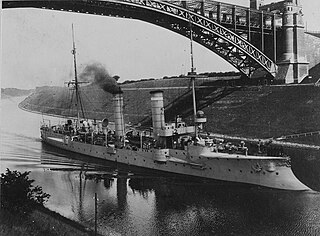
SMS Medusa was a member of the ten-ship Gazelle class of light cruisers that were built for the German Kaiserliche Marine in the late 1890s and early 1900s. The Gazelle class was the culmination of earlier unprotected cruiser and aviso designs, combining the best aspects of both types in what became the progenitor of all future light cruisers of the Imperial fleet. Built to be able to serve with the main German fleet and as a colonial cruiser, she was armed with a battery of ten 10.5 cm (4.1 in) guns and a top speed of 21.5 knots. Medusa served in all three German navies—the Kaiserliche Marine, the Reichsmarine of Weimar Germany, and the Kriegsmarine of Nazi Germany—over the span of over forty years.
HNoMS Tor was a Sleipner-class destroyer of the Royal Norwegian Navy that was launched in September 1939. She was under outfitting and testing when Nazi Germany invaded Norway on 9 April 1940. Although scuttled by Norwegian naval personnel to prevent her from being captured by the invading forces, she was soon salvaged by the Germans and put into service with the Kriegsmarine. Under the name Tiger she served out the war as an escort and training vessel, being recovered by the Norwegians in Denmark after the German capitulation in 1945. After the war she was converted to a frigate and served until 1959.

The Type 1936 destroyers, also known as the Z17 class, were a group of six destroyers built for Nazi Germany's Kriegsmarine during the late 1930s, shortly before the beginning of World War II. All six sister ships were named after German sailors who had been killed in World War I. They were engaged in training for most of the period between their completion and the outbreak of war, although several did participate in the occupation of Memel in Lithuania, in early 1939.

The Type 1934 destroyers, also known as the Z1 class or Leberecht Maass class after the lead ship, were a group of four destroyers built for the German Navy during the mid-1930s, shortly before the beginning of World War II. The ships were engaged in training for most of the period between their commissioning and the outbreak of war, although they did participate in the occupation of Memel in Lithuania, in early 1939. Z3 Max Schultz collided with and sank a German torpedo boat shortly before the war began on 1 September 1939. All four ships were named after German officers who had been killed in World War I.

Albatros was the fourth of six Type 23 torpedo boats built for the German Navy. Completed in 1927, Albatros often served as a flagship of torpedo boat units. The ship made multiple non-intervention patrols during the Spanish Civil War in the late 1930s. After an attack by aircraft of the Spanish Republican Air Force killed German sailors in 1937, she participated in the retaliatory bombardment of Almería.

















